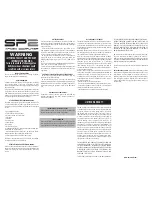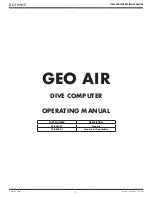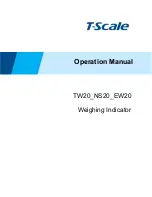
Zero
Zero
Zero
Zero----setting and Measurement
setting and Measurement
setting and Measurement
setting and Measurement
【Caution】 All operations are disabled while the prism LED is flashing.
Zero
Zero
Zero
Zero----setting
setting
setting
setting
【Caution】
◇
Zero-set the instrument at the beginning of each day before use as well as after replacing the batteries.
◇
Let water on the prism acclimate to the temperature of the instrument before zero-setting.
◇
When
“
AAA
”
is displayed, wipe the prism clean, apply water, and press the ZERO button again.
3.
3.3.
3.
M
MM
Measure
easure
easure
easurement : not
ment : not
ment : not
ment : not 0.0
0.0
0.0
0.00000
Then press the ZERO
button while the
water is on the prism.
4.
4.4.
4.
Zero-setting is
complete when
“
000
”
blinks
twice and then stops.
M
MM
Measure
easure
easure
easurement :
ment :
ment :
ment : 0.
0.0.
0.00000000
1.
1.1.
1.
Wipe the prism clean
and apply about 0.3ml of
tap/distilled water.
2.
2.2.
2.
Press the START button
to start measuring.
C
Measurement
Stop taking measurements.
C
How to stop measuring
The instrument is zero-set
correctly.
Proceed to
Proceed to
Proceed to
Proceed to measurement.
measurement.
measurement.
measurement.
Wipe the prism clean with
tissue paper.
Measurement
Measurement
Measurement
Measurement
【Caution】
◇
Do not use metal tools to apply samples on the prism as they may scratch the prism.
◇
Initial measurements may fluctuate with hot or cold samples. Wait for the instrument to acclimate to the sample temperature,
approximately 20 seconds, to press the START button. Alternatively, press the START button multiple times until
measurements become stable.
◇
Do not splash water above 30℃. The plastic may warp, which may compromise the water resistance.
•
When measuring hot samples, place only the necessary amount and do not let it overflow from the sample stage well.
•
When hot water is necessary to clean off hardened samples, use water-soaked gauze around the prism area and keep hot
water away from the body case.
◇
The displayed temperature is that of the prism and may not necessarily match the temperature of the sample.
1.
1.1.
1.
Wipe the prism clean and
apply about 0.3ml of the sample.
2.
2.2.
2.
Press the START
button.
3.
3.3.
3.
“
---
”
flashes until
measurements stabilize,
4.
4.4.
4.
After
“
---
”
stops flashing,
measurement results are displayed
continuously.
<<<<Continuous
Continuous
Continuous
Continuous measurement
measurement
measurement
measurement display
display
display
display>>>>
Example: 24.04
The instrument will turn itself off after 2 minutes of continuous measurement,
<<<<How to stop measuring
How to stop measuring
How to stop measuring
How to stop measuring>>>>
<<<<How to turn off
How to turn off
How to turn off
How to turn off>>>>
1.
1.1.
1.
Hold down the START
button.
2.
2.2.
2.
Release once
“
StP
”
appears.
The last measurement is displayed.
1.
1.1.
1.
Hold down the
START button.
2.
2.2.
2.
Release once
“
OFF
”
appears after
“
StP.
”
The last measurement is retained for approximately 1 minute afterwards.
<<<<Tip for stable measurement
Tip for stable measurement
Tip for stable measurement
Tip for stable measurement>>>>
This model features the Mode-S technology for increased repeatability. For best results measuring hot or
cold samples, stop the measurement once measurements start to stabilize, and then press the START
button again.
<<<<For oily/fatty samples
For oily/fatty samples
For oily/fatty samples
For oily/fatty samples>>>>
Try stirring the sample on the prism while measuring to improve the repeatability of oily/fatty samples.
Cleaning
Cleaning
Cleaning
Cleaning
Wipe off the sample, rinse with water, and wipe off the water to clean the sample stage thoroughly.
Dry the sample stage completely with dry tissues.
Error Messages
Error Messages
Error Messages
Error Messages
The following messages alert the user when an operation has failed.
The battery is low.
The prism temperature is below the temperature
range.
The ZERO button was pressed with nothing or
something other than water on the prism.
The prism temperature is above the temperature
range.
The START button was pressed with nothing or an
insufficient amount of sample on the prism.
The sample measured outside the measurement
range.
The instrument is faulty.
(Replace the batteries. Contact ATAGO if this
error persists.)
Too much light is entering the prism, and the
instrument cannot measure accurately.
(Shade the sample stage with your hand and take
a measurement again.)
Replacing the Batteries
Replacing the Batteries
Replacing the Batteries
Replacing the Batteries
【Caution】
◇
Fasten the battery compartment cover tightly to prevent water ingress or poor connection, which will
cause erroneous measurements. Push the cover in firmly and turn.
◇
When the O-ring on the cover is dirty or damaged, the water resistance may be compromised.
Lubricate the O-ring regularly (Figure 1)
◇
When the battery icon indicates the low power level (
), replace both batteries with a brand new
set of AAA alkaline batteries (1.5V).
◇
Static images may occasionally appear on LCD. Such retained pixel charges do not indicate a faulty
display, consume the battery power, or affect the instrument
’
s performance in any way.
◇
Check the expiration dates on batteries before purchase.
◇
Zero-set the instrument after the batteries are replaced.
1.
1.1.
1.
Insert a coin in the
groove on the battery
compartment cover. Turn
the coin counterclockwise
to remove the cover.
2.
2.2.
2.
Insert batteries,
observing the correct
polarity.
3.
3.3.
3.
Align the cover and push
it down.
4.
4.4.
4.
Close the battery
compartment cover by
pushing the cover in with a
coin in the groove and turning
it clockwise until it stops.
Solvents Harmful to Body Case
Solvents Harmful to Body Case
Solvents Harmful to Body Case
Solvents Harmful to Body Case
Aqua regia/chromic acid/chlorosulfuric acid/hydrobromic acid/nitric acid/hydrofluoric acid/sulfuric acid/phosphoric acid/ethyl acrylate/
butyl acrylate/ethyl acetoacetate/acetophenone/benzyl benzoate/ethylbenzene/ethylene oxide/ethylenediamine/ethylene chlorohydrin/
epichlorohydrin/ethyl chloride/benzyl chloride/methyl chloride/chlorinated solvents/xylene (xylol)/cresol/chloroacetone/chlorotoluene/
chloroform/acetic acid/amyl acetate/isopropyl acetate/ethyl acetate/butyl acetate/propyl acetate/methyl acetate/diphenyl oxide/
diisopropyl ketone/carbon tetrachloride/dioxane/cyclohexanone (anone)/dichlorobenzene/dibutyl phthalate (DBP)/dimethylformamide (DMF)
/dimethylaniline/phenol/thioalcohol (mercaptan)/tetrahydrofuran (THF)/trichloroethylene/toluene (toluol)/ethylene dichloride/
dichloromethane/nitroethane/nitropropane/nitrobenzene/nitromethane/perchlorethylene/fluorobenzene/methyl methacrylate/methyl
isobutyl ketone/methyl ethyl ketone/monochloroacetic acid/monochlorobenzene/liquid chlorine/thionyl chloride/sodium peroxide/bromine/
benzene/lacquer
Solvents that are harmful to the plastic body case include but not limited to the above substances.
Approx.
2mm
Approx. 0.3ml of sample
4
4.04
24.0
04
24
---
Flashing
---
Approx. 0.3ml of water
Approx.
2mm
Groove
Clean oily residues with ethyl alcohol or mild soap, and then, rinse with water.
For oily samples:
For oily samples:
For oily samples:
For oily samples:
Figure1
O-ring
(ES) Equipements Scientifiques SA - Département
Bio-tests & Industries
- 127 rue de Buzenval BP 26 - 92380 Garches
Tél. 01 47 95 99
90
- Fax. 01 47 01 16 22 - e-mail:
bio
@es-france.com - Site Web: www.es-france.com






















